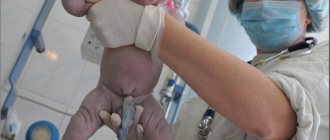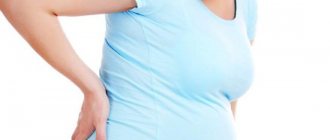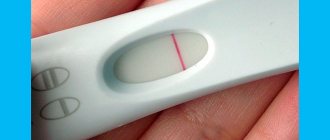Home / Complications of childbirth / Postpartum complications, or what should women be wary of?
21225
1
There is probably no woman who is not afraid of childbirth. After the birth of a child, all the fears that have tormented us for 9 months are left behind. It seems that a new life stage has begun in life - joyful and serene, because the long-awaited baby has finally been born.
However, no woman is immune from postpartum complications. Any representative of the fair sex can encounter them. Why complications arise after childbirth, what abnormalities and health problems can be detected in a woman are questions to which we have to find answers.
Postpartum endometritis
As you know, endometritis (inflammation of the mucous membranes of the uterus) is one of the most common complications that most women have to face during the postpartum period. 7% of women in labor experience this disease, mostly women who have had a cesarean section.
After childbirth, the uterus is a large wound. There are two stages of its healing : inflammation and restoration of the mucous membrane.
Thanks to these stages, the uterus is cleansed inside. But if any pathogenic microorganisms are present, the inflammation can develop into chronic inflammation.
How to recognize?
There are severe endometritis , which can appear on the second to fourth day after birth, and mild endometritis , which can occur a little later.
In this case , the temperature rises to 38°C, the pulse quickens, the body shudders, pain occurs in the lower abdomen and lower back, which can intensify during breastfeeding.
Unpleasant brown discharge appears, which soon becomes purulent. With this disease, the uterus contracts more slowly than usual.
But elevated temperature (for example, 37.5°C) and weakness in the first days can be explained by the arrival of milk, and not by inflammation.
Prevention and treatment
Before giving birth (and preferably before pregnancy), it is imperative to identify and try to get rid of any infectious diseases.
In cases of high risk of endometritis and only as prescribed by a gynecologist, antibiotics may be taken for prevention purposes.
Complications after caesarean section
All of the above ailments can appear after a cesarean section. Special complications after surgery are called:
- Spikes. Adhesions are the fusion of internal structures of the body with ropes or loops of connective tissue. They prevent the spread of inflammation, but if there are too many of them, dissonance occurs in the abdominal cavity. Adhesions can occur both before and after childbirth. The most effective methods of control and prevention are physiotherapy and hirudotherapy.
- Bleeding and hematomas in the suture area. Pathologies occur if the suture is applied incorrectly and due to rough mechanical handling during dressing changes and processing.
- Purulent-inflammatory phenomena. If an infection penetrates through the suture or insufficient treatment is performed, the nearest area becomes red, swollen, the temperature rises, and a bloody-purulent substance is released from the suture.
- Seam divergence. In rare cases, approximately 7-10 days after surgery, the suture may begin to unravel. Possible causes are infection or carrying heavy objects.
- Ligature fistulas. Sometimes the skin around the suture threads becomes thickened and fistulas form. The skin turns red, the lumps may be hot and painful, and pus is released. If measures are not taken in time, an abscess may develop. In case of fistula formation, repeated suture is required.
- Hernia. It occurs rarely, more often with a longitudinal incision or several pregnancies in a row ending in surgery.
- Keloid scar. An aesthetic complication characterized by an overly large, uneven scar.
More on the topic
Why does uterine prolapse occur after childbirth and what could be the consequences?
What to do if there is no milk after childbirth?
Can there be black stool after childbirth?
Complications during and after childbirth
Discharge after childbirth with an unpleasant odor
Pathological bleeding after childbirth
In fact, bleeding after childbirth cannot be called a symptom of pathology; this phenomenon is completely natural for this period.
After childbirth, the uterus spontaneously returns to its previous size. With such contractions of the uterus, blood is released from the vagina. This process of contraction is similar to heavy periods.
During the normal course, in the first week after birth they are abundant, have a thick consistency and a bright red color. After some time, they turn pale, become scarce and completely stop after one and a half to two months. When breastfeeding, such bleeding stops earlier, and for those who have had a cesarean section , on the contrary, it lasts a little longer.
But it also happens that the discharge becomes pathological.
How to recognize?
If the bleeding two weeks after birth is just as heavy, has a bright red color, has also acquired an unpleasant odor, and even worse has turned purulent, you should be wary.
All of the above may be the beginning of a developing complication that requires the help of a doctor.
Delayed postpartum bleeding is also dangerous This indicates a bending of the uterus or its slow contraction. In this case, there is an increase in temperature, heaviness in the abdomen, chills, and a significant decrease in discharge.
Preventive measures
Firstly , it is necessary to observe the following rules of genital hygiene: during bleeding and when there are stitches after childbirth, it is recommended to wash with cool, clean water every time after going to the toilet.
Secondly , sanitary pads should be changed preferably every four hours and not allowed to fit tightly during the first week.
The inflammatory process can be caused by microbes coming from the vagina or from the origin of a chronic infection inside the body.
Here are some useful tips to prevent abnormal bleeding:
- promptly cure all possible infections, in particular gynecological ones;
- do not use sanitary tampons;
- To make the uterus contract faster after childbirth, try to lie on your stomach more;
- go to the toilet on time;
- If the birth was successful, without complications, try to start moving as soon as possible.
Do I need a bandage after childbirth? Read here.
This section contains a lot of useful information that you need to know when planning a pregnancy.
Thrombophlebitis
With this complication, the femoral veins are affected. Thrombophlebitis appears two or three weeks after birth. Its main features include:
4.38 out of 5 (8 Votes)
A woman who has given birth to a child is in the postpartum ward under close attention. The doctor monitors her body temperature, vaginal discharge, and uterine contractions. The information obtained is very important, because thanks to it it is possible to diagnose various complications in a timely manner. One of them may be postpartum endometritis. It is a fairly serious and life-threatening disease.
The internal cavity of the uterus is lined with endometrium. Due to the penetration of infections after childbirth, the membrane may become inflamed. This process is called endometritis.
According to its form, inflammation is divided into 2 types: acute and chronic. Their symptoms are the same, but in form 2 they are a little blurry. Chronic endometritis is more difficult to recognize and treat. That is why at the first signs of endometritis you should immediately contact the clinic.
Symptoms of acute endometritis
As a rule, the disease begins with the following symptoms:
- increase in body temperature to 38-39 degrees;
- the occurrence of pain in the lower abdomen, radiating to the sacrum;
- the appearance of bloody-purulent, serous-purulent, serous discharge from the vagina;
- ailments (weakness, weakness, headache).
Particular attention should be paid to such symptoms of postpartum endometritis as discharge. Normally, after the birth of a child, heavy discharge with blood occurs within a couple of days. Then they become scanty and acquire brownish and yellowish shades.
By the 8th week, the discharge completely stops. With endometritis, they are profuse and bloody for a long time. Their color may even be greenish.
Symptoms of chronic endometritis
Characteristic signs of a chronic form of inflammation of the inner lining of the uterus include:
- not falling body temperature;
- uterine bleeding that occurs from time to time (irregularly);
- discharge from the genital tract with an unpleasant (putrefactive) odor;
- pain during bowel movements.
Causes of endometritis
The main cause of inflammation of the inner lining of the uterus is the entry of microorganisms into the organ on a damaged surface that occurs after the separation of the placenta. They can enter the uterus in 2 ways:
- from the vagina;
- from foci of chronic infection.
Opportunistic microbes can live in a woman’s vagina. For a long time they can live on mucous membranes and not bother their owner. However, when living conditions change, they can cause various diseases. This is especially true for streptococci and staphylococci. Microorganisms may become active due to difficult labor. The cause of postpartum endometritis can also be those infections that are sexually transmitted.
Microorganisms can enter the uterus from foci of chronic infections through the hematogenous, lymphogenous route (that is, with blood or lymph). For example, this can happen if a woman suffers from chronic tonsillitis or nephritis.
Predisposing factors for the development of inflammation and risk groups
Predisposing factors for postpartum endometritis include:
- gestosis (a complication of the 2nd half of a woman’s “interesting position”, manifested by increased blood pressure, the appearance of protein in the urine, and edema);
- prolonged labor, premature rupture of amniotic fluid and a long anhydrous period;
- incorrect placement of the fetus in the uterus;
- childbirth in women under 19 years of age;
- childbirth among representatives of the fair sex, whose pregnancy is their first and who are over 30 years old;
- childbirth in women with a narrow pelvis;
- placenta previa (it partially or completely blocks the exit from the genital organ);
- premature detachment of the placenta, which is normally located;
- infection at the time of birth with microorganisms that are sexually transmitted and cause various diseases.
Women who are at risk for inflammation of the inner lining of the uterus deserve special attention after childbirth. Typically, after the baby is born, they are sent for an ultrasound.
The risk group includes those women who have:
- abortions (the more there are, the higher the risk);
- complications from previous pregnancies, childbirth;
- foci of chronic infections in the body.
Complications of endometritis
Inflammation of the lining of the uterus can lead to sepsis. This complication is also called “blood poisoning.” There is a risk that if left untreated for a long time, the infection will spread throughout the body through blood and lymph.
Complications of postpartum endometritis can also include:
- progression of the disease into a chronic form;
- formation of pyometra (pus accumulates in the uterine cavity and does not come out due to obstruction of the cervix);
- the occurrence of pelvioperitonitis as a result of pus entering the pelvic cavity;
- the occurrence of salpingitis and oophoritis (inflammation of the fallopian tubes and ovaries).
Severe purulent-septic complications can result in uterine amputation and death.
If untimely and incorrect treatment is used, the following consequences may occur in the future:
- menstrual irregularities;
- constant discomfort in the lower abdomen;
- reproductive dysfunction (infertility, spontaneous miscarriages).
The list of consequences of endometritis is not exhausted by all of the above complications. The inflammatory process can cause any pathology. To prevent the occurrence of severe complications, it is necessary to seek help from a specialist in time.
As evidence of the seriousness of the pathologies, it can be noted that from the 17th to the beginning of the 20th century, endometritis (“puerperal fever”) was a serious problem in maternity hospitals, which, due to the lack of suitable treatment, turned into sepsis. The disease claimed the lives of 50% of women giving birth.
Chorioamnionitis (inflammation of the membranes of the fetus and uterus)
This complication occurs in the case of premature rupture of the membranes of the fetus.
And the longer the waterless period lasts, the greater the likelihood of infection of the fetus while it is still in the womb.
How to recognize?
Due to the long anhydrous period, which is from 6 to 12 hours, the woman in labor experiences: elevated temperature, rapid heartbeat, chills, and purulent discharge from the vagina.
Statistics show that in every fifth woman after childbirth, chorioamnionitis can develop into endometritis.
Treatment of chorioamnionitis
If chorioamnionitis occurs, urgent stimulation of labor is performed (in case of lack of strength during childbirth, a caesarean section) using antibacterial and infusion therapy.
Complications during childbirth
In medical practice, doctors consider many birth options to be complicated in advance. This category includes:
- childbirth in women with late toxicosis;
- childbirth in women who have chronic diseases of the kidneys, heart and other organs, diabetes mellitus;
- childbirth of HIV-infected women;
- premature birth (before 37 weeks of pregnancy);
- childbirth in women who are carrying more than one fetus, that is, multiple births;
However, doctors prepare for all these situations in advance, if the woman was registered with a gynecologist and was monitored until the very beginning of labor. Often this category of women is offered to go to hospital for 37-38 weeks under the full supervision of doctors in order to avoid negative consequences (this does not apply to premature birth, they happen suddenly if there were no warning signs).
Childbirth in women at risk will not necessarily be accompanied by complications. This danger is potential.
But there is a whole group of situations that could not be foreseen in advance.
1. Pathological preliminary period. The preliminary period is the preparation of the female body for childbirth. At this time, the cervix becomes soft. This helps her stretch easily during contractions. The normal course of the preliminary period is painless and is characterized by irregular contractions of the uterus.
In most cases, this period occurs at night, when the woman is sleeping peacefully and wakes up from constant contractions. If a woman is tuned in to terrible pain and is afraid of childbirth itself, then the preliminary period can be painful.
Normally it lasts 6-8 hours. But it also happens that, for unknown reasons, these preparatory contractions do not progress into labor for a long time. Then they talk about such a complication of childbirth in women as a pathological preliminary period. You can recognize it by the following signs:
- irregular contractions that cause pain not only at night, but during the day and do not progress into labor;
- in the presence of preparatory contractions, the uterus does not change, remaining long and dense (the doctor can see this during examination);
- during the preliminary period, the fetus is not pressed against the entrance to the pelvis (determined by a gynecologist);
- increased tone of the uterus;
- over a long period of preparatory contractions.
This complication of childbirth is easily treatable with medication. In this case, the woman is offered rest (medicated sleep), analgesics, sedatives, vitamins, and antispasmodics are prescribed. All treatment lasts no more than 5 days. As a result of treatment, contractions stop and appear again after some time, when the uterus has matured and the body is ready for childbirth. If treatment is ineffective, then surgical delivery is resorted to.
2. Weakness of labor. The complication is due to the woman’s body lacking its own strength to complete childbirth. Weak labor can be primary or secondary:
- primary is characterized by weak contractions at the very beginning. The contractions that appear do not intensify to push the baby out;
- Secondary weakness occurs when normal strong contractions begin to weaken.
As a result of such a complication, the child may develop oxygen starvation.
Depending on the cause of the problem and the period in which it occurs, medication (oxytocin) may be prescribed to induce labor. In case of primary labor weakness, time may be allocated for the woman in labor to rest.
In severe cases, a caesarean section is resorted to. Learn more about surgical delivery →
3. Violent labor activity. This is the exact opposite of weak labor. In this case, labor proceeds rapidly. This can lead to ruptures in the mother and injury to the baby. Also, with this complication, a woman may experience premature placental abruption. Violent labor is particularly painful, but is easily amenable to drug intervention, which reduces the tone of the uterus and reduces pain.
4. Early rupture of amniotic fluid. Normally, the waters recede after the cervix is completely open. Between the outpouring of water and the birth of the baby, no more than 18 hours should pass, otherwise the baby may become infected, the umbilical cord or the arm may fall out of the uterus. When rupture occurs, even before the cervix dilates, they resort to stimulation of labor or surgical intervention.
5. Premature placental abruption. Normally, the placenta detaches after the baby is born. Labor is not even considered complete until the placenta is delivered. Premature detachment can occur during very strong contractions or in cases where blood clotting is impaired in such a situation. With this complication, bleeding in the mother and hypoxia in the fetus may occur. Almost always in such a situation they resort to caesarean section.
6. Narrow pelvis. This diagnosis can be made at the last ultrasound before childbirth, or it can be made directly during childbirth. This is due to the fact that a woman’s normal pelvis for some reason does not allow the baby’s head to pass through it. Maybe the fetus is very large, or maybe the head has turned incorrectly at the entrance to the pelvis. Labor is delayed, which leads to oxygen starvation of the fetus. Here they resort to emergency caesarean section.
7. Breaks in a woman. Small tears are treated but are not considered a complication. Complications include deep ruptures during the birth of a large fetus or violent labor. The doctor, foreshadowing such a possibility, usually makes an artificial incision, which is then sutured and which heals much easier and faster than a natural one.
8. Fetal hypoxia. In fact, each contraction is a short-term hypoxia of the fetus - a lack of oxygen. That is why they say that proper breathing is very important during childbirth. Your breath is oxygen for the baby. Hypoxia, which in severe cases can lead to death, is associated with rapid labor, entanglement of the umbilical cord, and early placental abruption. In this case, it is important to eliminate its cause and prompt delivery.
9. Prenatal trauma. This is an injury to a newborn sustained during childbirth. This complication can occur during rapid labor and premature birth, when the child is still immature and weak. It is also possible for the child to be injured if the head enters the pelvis incorrectly and due to unqualified actions of obstetricians.
Any complication during childbirth can have serious consequences for the baby's health. Therefore, during the entire process, doctors carefully monitor the condition of the fetus. Not only the well-being of the woman in labor, but also the child’s child can be an indicator for surgical intervention. Before the operation, doctors eliminate the cause of the deterioration of the condition and improve blood supply to the fetus. Only if there is no improvement in the field of conservative methods, proceed to a caesarean section.
Postpartum mastitis (inflammation of the mammary glands) and lactostasis (milk stagnation)
This disease can only affect nursing mothers. The causative agent is Staphylococcus aureus.
It can be infected through cracks in the nipples (unlike mastitis, lactostasis progresses without the presence of cracks).
Basically, mastitis appears in those who give birth for the first time (in 2-5% of cases); it can begin either in the third week after birth or a month later.
How to recognize?
Postpartum mastitis occurs with elevated temperature (up to 38.5°C and above), headache, weakness, chills, characteristic pain in the mammary gland, breast swelling and redness.
Manual examination reveals painful lumps. Feeding or pumping with developed mastitis is accompanied by acute pain, while with lactostasis, on the contrary, relief is felt.
Lactostasis must be distinguished from mastitis. With lactostasis , milk is expressed freely and becomes easier, the temperature returns to normal, there is no redness or swelling, and the pain subsides.
Preventive measures
These include:
- fully express breast milk after each feeding, avoid stagnation;
- correct attachment of the baby to the breast (the nipple and areola should be completely covered);
- timely treatment of cracked nipples, lactostasis;
- compliance with the rules of hygiene and breastfeeding techniques;
- wearing a bra that is not too tight;
- carrying out air baths for the breast (10-15 minutes after feeding).
Consequences of premature birth
Normally, the baby prepares to leave the mother's womb by the 40th week of pregnancy. If contractions start earlier and labor occurs before the due date, something has gone wrong. Premature birth is dangerous for both mother and baby. The most dangerous consequences:
- Prolonged, deep postpartum depression occurs due to the fact that the mother begins to blame herself for what happened;
- The baby’s poorly developed respiratory system requires connection to special breathing apparatus;
- A premature baby is often not yet able to feed himself, so he needs to be connected to an artificial feeding machine;
- Chronic lung diseases in children;
- Slow mental development, up to dementia;
- Reduced immunity, tendency to frequent infectious, inflammatory, chronic diseases;
- Character traits: tearfulness, capriciousness, emotionality;
- Delayed physical development. Premature babies, as a rule, begin to crawl, sit, and walk later.
Some complications after childbirth cannot be predicted, while others, for example, inflammatory diseases, can be prevented at the stage of pregnancy planning. The birth of a child is the most pleasant and long-awaited moment in the life of every woman, so it is better not to let it be overshadowed by unpleasant consequences and take care of your health.
Especially for beremennost.net – Elena Kichak
Inflammation of the urethra
It is considered normal if in the first days after childbirth, a woman experiences pain during urination, as well as a burning sensation.
But if this continues , even when the tears and stitches in the perineal area have already healed, an inflammatory process may have begun and an infection may develop.
How to recognize?
Symptoms of inflammation:
- difficult and painful urination, or the presence of desire, but without urine discharge, or scanty discharge;
- elevated temperature;
- cloudy urine color and pungent odor;
- presence of pain on both sides of the lower back.
Causes:
- use of a catheter during childbirth;
- in case of violation of the integrity of the bladder during natural childbirth;
- low bladder tone (especially after epidural anesthesia);
- injuries when using obstetric forceps.
Hematometer
The cause of blood accumulation in the uterine cavity can be a relaxation of its cervix. This condition results in poor contraction of the uterus and an inability to push blood out of the cavity. A complication can occur due to fragments of placental tissue remaining in the uterus or inflammatory processes. Characteristic symptoms of the disease are:
- pain or heaviness in the lower abdomen;
- temperature increase;
- sudden cessation of discharge after childbirth.
If you do not contact a gynecologist in a timely manner, hematometra can cause purulent inflammation in the uterus and appendages. In extreme cases, the complication leads to removal of the uterus. For treatment, special drugs are used that increase uterine contractility. Curettage under general anesthesia is rarely used.










